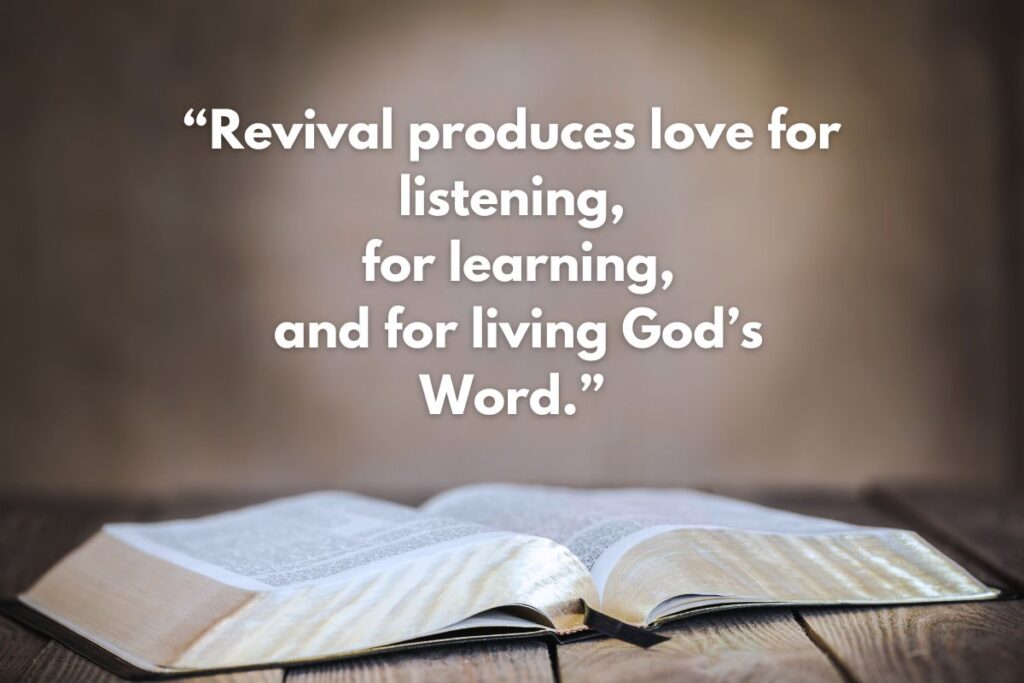Here are some key signs of true revival.
Nehemiah, while in captivity, received word about the ruins of Jerusalem. The news broke his heart (1:4).
In chapter 2 he requested permission from the king to return to Jerusalem to rebuild the city (2:5). While in Jerusalem, he unites the people “for this good work” (2:18). They faced opposition, yet they finished the wall in fifty-two days (6:15). They rebuilt that which sat in ruins for 140 years.
Now that the wall is complete Nehemiah begins to revive the people. In 7:1, Nehemiah appointed porters, singers, and Levites which indicates a plan to restore worship. We now see a nation coming back to God. Notice 7 signs of genuine revival from Nehemiah chapter 8..
1. National Unity (8:1)
The first sign of revival is that people assembled as “one man.” Unity is the absence of discord or division. Division among God’s people, according to 1 Corinthians 3 is carnal, but revival binds people together. In Nehemiah 4:6, “the people had a mind to work,” and in chapter 8 the people had a heart to worship.
Unity is present in every great revival. A “one accord” prayer meeting preceded the demonstration of the power of God on the Day of Pentecost. Pentecost was the outcome of a one accord prayer meeting that began in Acts 1:14 and continued in 2:1.
Is it possible to reach the Northeast in great numbers as the Apostles reached their own in Jerusalem while we are as divided as the church at Corinth? (1Co.1:10-13) If we will reach New England for Christ, we must have revival. The Greek word translated “one accord” is a compound of two words meaning to “rush along” and “in unison.”
May God help us today to understand the value and the connection between revival, unity, and the demonstration of the power of God. Read Acts 4:23-24, 31-33. Leonard Ravenhill said, “The world is not waiting for a new definition of Christianity, but a new demonstration of Christianity.”

2. A Love for God’s Word (8:1-3, 7-8)
The people requested Ezra “to bring the book of the law of Moses” to resume reading and teaching. God had previously used Ezra to turn Israel back to the Word of God (Ezra 9-10). Consequently, after the second group of exiles returned to Jerusalem, God called upon Ezra again to help revive the people.
Today, services are being condensed. In some cases, churches are abandoning doctrine. Revival produces love for listening, for learning, and for living God’s Word. Ezra read the Scriptures from morning until midday after which he “gave the sense and caused them to understand the reading” during which time all the people stood in reverence.
Paul told Timothy in 2Ti. 4:2-4, “Preach the word; be instant in season, out of season; reprove, rebuke, exhort with all longsuffering and doctrine. For the time will come when they will not endure sound doctrine; but after their own lusts shall they heap to themselves teachers, having itching ears; And they shall turn away their ears from the truth, and shall be turned unto fables.”
We are living in a day that describes a culture including some churches that have turned away from the truth. An evidence of genuine revival is a return to the Scriptures.
3. An Awe for God’s Word (8:5-8)
Throughout chapter 8, we see an awe for the Word of God. They desired to hear the Word “from the morning until midday” (3), and they listened attentively for six hours while standing (5, 7). Clearly, a demonstration of reverence. The Apostle Paul told Timothy to “war a good warfare” concerning sound doctrine unlike some who “put away concerning faith have made shipwreck” (1Ti. 1:18-20). Revival restores a meaningful relationship with God’s Holy Word.
4. Corporate Prayer and Praise (8:5-6)
When Ezra opened the book, the people stood up, and “all the people answered, Amen, Amen, with lifting up their hands: and they bowed their heads, and worshipped the LORD with their faces to the ground.” Sadly, when we are lacking revival in our own lives and in the church, we are too busy for God, His Word, and prayer.
There is an apparent stirring of God’s Spirit in the Northeast that began in 2017. This stirring is drawing preachers together to corporately invest in church planting, to plan revival and Gospel meetings, and we are coming together to pray. My dear reader, the friendships, the unity of purpose, the corporate prayer meetings, including the number of new church plants in the New England area is unprecedented.
5. Tears of Repentance (8:9)
As the people listened to the Word of God, they began to weep. Nehemiah rebuked them because this was supposed to be a day of celebration. The wall was finished, and God had taken away their reproach. However, the Word of God affected their hearts. Revival produces tears, repentance, and a changed lives. Make it so, Lord!
6. Obedience to God’s Word (8:13-17)
The leaders returned to Ezra on the second day of the month to further understand the law. They discovered that they had neglected the Feast of Tabernacles. Verse 17 says, “all the congregation of them that were come again out of the captivity” responded in obedience and made booths in which they sat to commemorate His provision and protection during the 40 years in the wilderness.
Charles Finney said, “A revival is nothing else than a new beginning of obedience to God.”
7. Joy (8:10)
Joy is a result of having a right relationship with God. It is truly a sign of genuine revival. David’s joy was restored including a desire to teach sinners about God upon confessing his sin and getting right with the Lord (Read Ps. 51:1-13). The people of Judah have returned to Jerusalem to rebuild and to be restored to God. Consequently, the joy of the Lord is now their strength. In a day characterized by anxiety and depression, the geniune joy of God’s people point unbelievers to the Saviour.

